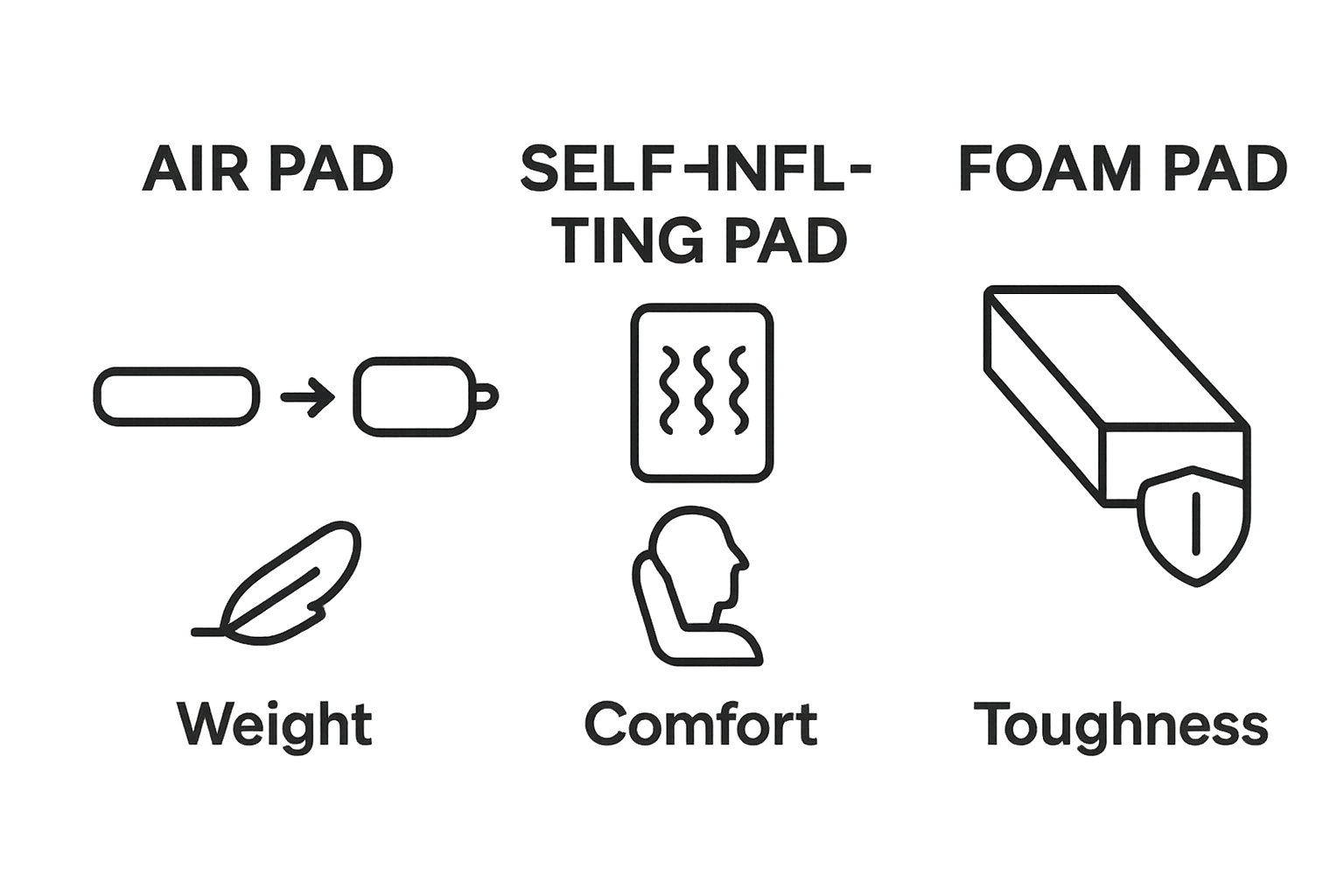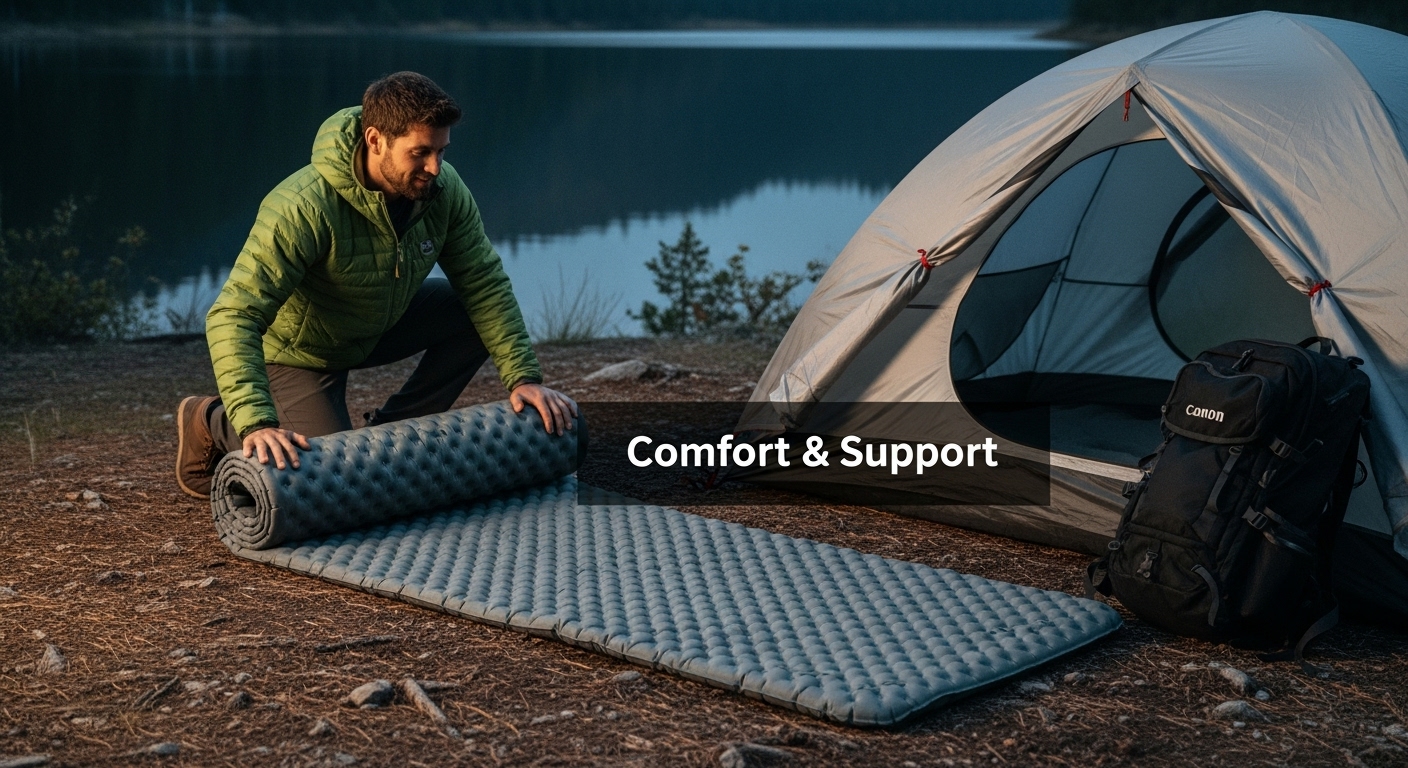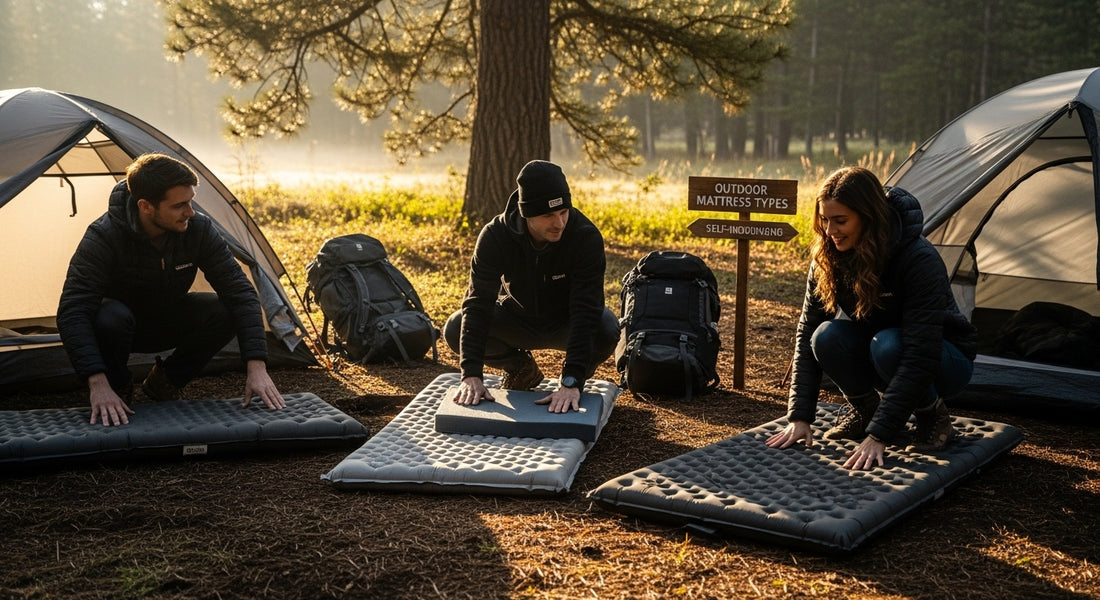Camping comfort used to mean little more than a thin pad and a prayer for good sleep outdoors. Now outdoor mattresses have completely redefined expectations. Some air pad models weigh as little as 12 ounces, making them lighter than a water bottle and yet still provide proper insulation from the ground. You might think these technical advances only matter for elite mountaineers or ultralight backpackers. The truth is even weekend campers are missing out if they ignore these new options, because the right outdoor mattress can transform any night under the stars.
Table of Contents
- What Are Outdoor Mattress Types And Their Features?
- Why Choosing The Right Outdoor Mattress Matters
- How Different Materials Affect Outdoor Mattress Performance
- Key Concepts Of Outdoor Mattress Comfort And Support
- Understanding Outdoor Mattress Care And Maintenance
Quick Summary
| Takeaway | Explanation |
|---|---|
| Choose the right outdoor mattress | Selecting the appropriate mattress directly influences your comfort, recovery, and overall outdoor experience. |
| Air pads are lightweight and portable | They are compact, easy to pack, and adjustable for different firmness levels, making them ideal for minimalist travelers. |
| Self inflating pads offer stability | These pads combine foam and air technology, providing consistent insulation and a stable sleeping surface for outdoor enthusiasts. |
| Material choice impacts performance | Different materials like foam and synthetics affect weight, durability, insulation, and comfort, crucial for outdoor conditions. |
| Proper maintenance extends lifespan | Regular cleaning and appropriate storage practices significantly enhance mattress durability and performance during wilderness adventures. |
What are Outdoor Mattress Types and Their Features?
Outdoor mattresses are specialized sleeping solutions designed to provide comfort and insulation in various outdoor environments. Unlike traditional indoor mattresses, these portable sleep surfaces are engineered to withstand diverse terrain, temperature fluctuations, and compact storage requirements. Understanding the different types of outdoor mattresses can significantly enhance your camping, hiking, and adventure experiences.
Air Pads: Lightweight Comfort
Air pads represent a popular category of outdoor mattresses that prioritize portability and comfort. These mattresses are constructed using lightweight materials like nylon or polyester and can be manually or mechanically inflated. Key characteristics of air pads include:
- Compact and easily packable design
- Adjustable firmness through inflation levels
- Typically weighing between 12 to 20 ounces
- Providing excellent insulation from ground temperatures
Campers and backpackers often prefer air pads because they can be compressed into small stuff sacks, making them ideal for minimalist travelers who prioritize weight and space efficiency.
Self Inflating Pads: Hybrid Performance
Self inflating pads combine the best features of foam and air mattress technologies. These innovative sleep surfaces use open cell foam that automatically expands when the valve is opened, requiring minimal manual effort. Learn more about outdoor mattress technology to appreciate the engineering behind these remarkable products.
These mattresses offer superior advantages such as:

- Consistent thermal insulation
- More stable sleeping surface compared to pure air pads
- Moderate weight range (typically 1 to 2 pounds)
- Enhanced durability and puncture resistance
Outdoor enthusiasts appreciate self inflating pads for their balance between comfort, performance, and convenience during camping and backpacking adventures.
Why Choosing the Right Outdoor Mattress Matters
Choosing an appropriate outdoor mattress is far more than a simple comfort decision. It directly impacts your physical health, sleep quality, and overall outdoor experience. Research from outdoor recreation experts demonstrates that the right mattress can significantly influence your body’s recovery, temperature regulation, and protection during wilderness adventures.
Physical Comfort and Recovery
Outdoor mattresses play a critical role in supporting your body during intense physical activities. After a long day of hiking, climbing, or exploring challenging terrains, your muscles require proper rest and support. The right mattress provides essential pressure distribution, preventing painful pressure points and allowing muscular recovery. Factors like thickness, material composition, and insulation properties directly contribute to how well your body recuperates during sleep.
Key considerations for physical recovery include:
- Adequate cushioning to reduce muscle strain
- Proper spinal alignment during rest
- Minimizing ground contact pressure points
- Supporting natural body contours
Temperature and Environmental Protection
Beyond comfort, outdoor mattresses serve as critical thermal barriers between your body and the ground. Explore our guide on camp bedding organization to understand how strategic mattress selection protects against environmental challenges.
The insulation properties of your mattress determine how effectively you maintain body heat in various outdoor conditions. Different environments require specific mattress characteristics:
- Alpine regions demand high R-value insulation
- Desert environments need breathable materials
- Humid climates require moisture resistant surfaces
- Rough terrains necessitate puncture resistant designs
Making an informed mattress choice means understanding these nuanced environmental interactions and selecting a product that matches your specific outdoor context. Your sleep system is not just equipment but a critical component of your safety and comfort strategy during outdoor adventures.
How Different Materials Affect Outdoor Mattress Performance
The performance of an outdoor mattress is fundamentally determined by its underlying material composition. Outdoor gear performance research reveals that material selection directly influences critical factors like weight, durability, insulation, and comfort. Understanding these material characteristics becomes crucial for selecting the most appropriate outdoor sleeping solution.
Foam Materials: Durability and Insulation
Foam materials represent a cornerstone of outdoor mattress technology. These materials are categorized into two primary types: closed-cell and open-cell foam. Closed-cell foam provides exceptional insulation and durability, featuring a dense structure that prevents moisture absorption and offers superior thermal protection. Open-cell foam, conversely, delivers enhanced comfort through its more breathable and compressible structure.
Key advantages of foam materials include:
- Consistent thermal performance
- Resistance to moisture and environmental degradation
- Lightweight and compact design
- Minimal maintenance requirements
Synthetic and Synthetic Blend Materials
Check out our camp mattress cleaning guide to understand how different materials require specific maintenance approaches. Synthetic materials like polyester and nylon bring unique performance characteristics to outdoor mattresses. These synthetic fabrics offer remarkable strength-to-weight ratios, excellent tear resistance, and quick-drying properties.
Synthetic blend materials provide additional performance benefits:
- Enhanced puncture resistance
- Improved water repellency
- Reduced overall weight
- Greater flexibility in design and construction
By carefully selecting materials that match specific outdoor environments and personal usage requirements, adventurers can optimize their sleeping experience and ensure reliable performance across diverse terrain and weather conditions.
This table outlines how different mattress materials impact performance factors relevant to outdoor use, making it easier to choose what fits your priorities and adventure needs.
| Material Type | Key Properties | Insulation | Durability | Weight | Maintenance Needs |
|---|---|---|---|---|---|
| Closed-cell Foam | Dense, moisture-resistant | High | High | Light | Low |
| Open-cell Foam | Soft, compressible, breathable | Moderate | Moderate | Light | Low |
| Polyester/Nylon (Synthetic) | Tough, flexible, quick-drying | Varies | High | Very Light | Moderate |
| Synthetic Blends | Enhanced puncture/water resistance | Varies | Very High | Light | Moderate |
Key Concepts of Outdoor Mattress Comfort and Support
Outdoor mattress comfort extends far beyond simple cushioning, representing a complex interplay of ergonomic design, material science, and human physiological needs. Biomechanical research in outdoor sleep systems reveals that effective outdoor mattresses must address multiple dimensions of physical support and environmental adaptation.
Ergonomic Support Principles
Ergonomic support in outdoor mattresses focuses on maintaining natural body alignment and distributing body weight evenly. This concept goes beyond traditional comfort, targeting muscular recovery and spinal health during challenging outdoor experiences. The ideal outdoor mattress creates a responsive surface that adapts to body contours, reducing pressure points and minimizing potential strain during sleep.
Key ergonomic considerations include:
- Maintaining neutral spine positioning
- Preventing localized pressure concentration
- Supporting natural body curvature
- Accommodating different sleeping positions
Thermal Regulation and Comfort Zones
Explore our guide on understanding memory foam outdoors to comprehend how advanced materials contribute to thermal comfort. Thermal regulation represents a critical aspect of outdoor mattress performance, directly influencing sleep quality and physiological recovery.
Thermal comfort zones are determined by several interconnected factors:
- Insulation value (R-value)
- Material heat conductivity
- Moisture management capabilities
- Air circulation properties
By understanding these intricate relationships between materials, body mechanics, and environmental conditions, outdoor enthusiasts can select mattresses that provide comprehensive comfort beyond simple cushioning. The right outdoor mattress becomes a sophisticated sleep system designed to support physical recovery and enhance overall wilderness experience.

Understanding Outdoor Mattress Care and Maintenance
Outdoor mattress maintenance is a critical aspect of preserving equipment performance and extending its operational lifespan. Outdoor equipment maintenance research demonstrates that systematic care directly impacts mattress durability, insulation capabilities, and overall functionality in challenging wilderness environments.
Cleaning and Surface Protection
Proper cleaning techniques vary significantly between different outdoor mattress materials. Synthetic materials like polyester and nylon require gentle cleaning approaches that preserve their protective coatings and structural integrity. Water resistant treatments can be compromised by aggressive cleaning methods, reducing the mattress ability to repel moisture and maintain thermal performance.
Key cleaning considerations include:
- Using mild non detergent soap solutions
- Avoiding harsh scrubbing techniques
- Cleaning after each extended outdoor trip
- Removing dirt and potential biological contaminants
Storage and Long Term Preservation
Learn more about camp mattress organization strategies to understand comprehensive equipment maintenance. Proper storage represents a fundamental aspect of outdoor mattress longevity. Mattresses should be stored in cool, dry environments away from direct sunlight, with valves open to prevent moisture accumulation and potential mildew formation.
Critical storage practices involve:
- Storing mattresses in uncompressed state
- Keeping away from extreme temperature variations
- Protecting from direct UV radiation
- Maintaining consistent ambient humidity levels
By implementing systematic maintenance protocols, outdoor enthusiasts can significantly extend their mattress performance, ensuring reliable comfort and support across multiple wilderness expeditions.
Upgrade Your Outdoor Sleep With Hazli Collection
You have learned about outdoor mattress types and the challenges of finding a bed that truly supports your adventures. Are you tired of restless nights and sore mornings after a long hike? Whether you value thermal insulation, ergonomic support, or easy maintenance, you deserve a mattress that meets your needs in the wild and makes you feel at home anywhere.

Experience the difference with Hazli Collection’s premium memory foam mattresses and outdoor gear. Our products are designed to protect you from harsh temperatures and rough terrain so you can sleep soundly on any camping trip. Don’t settle for discomfort when you can explore the collection on our website and discover a better way to rest outdoors. Shop now to upgrade your outdoor comfort and enjoy fast, secure checkout with Shopify Pay. Your next adventure should start with a great night’s sleep—choose comfort that lasts.
Frequently Asked Questions
What are the different types of outdoor mattresses?
Outdoor mattresses mainly fall into three categories: air pads, self-inflating pads, and foam mattresses. Each type offers unique benefits tailored for different outdoor activities and comfort needs.
To help you compare the primary types of outdoor mattresses discussed, the following table summarizes their key features, advantages, and typical use cases.
| Mattress Type | Key Features | Weight Range | Advantages | Best For |
|---|---|---|---|---|
| Air Pad | Inflatable, compact, adjustable firmness | 12-20 ounces | Lightweight, packable, customizable | Backpackers, minimalist campers |
| Self-Inflating Pad | Foam + air hybrid, auto-expand with valve | 1-2 pounds | Stable, good insulation, durable | Campers seeking comfort & ease |
| Foam Mattress | Closed/open cell foam, no inflation needed | 9-24 ounces | Simple, reliable, insulation, durable | Harsh terrain, budget campers |
How do air pads compare to self-inflating pads?
Air pads are lightweight and portable, allowing for adjustable firmness through inflation. Self-inflating pads, on the other hand, combine foam and air features, providing stable support and better insulation without extensive manual inflation.
What materials are commonly used in outdoor mattresses?
Common materials include foam (closed-cell and open-cell), synthetic fabrics like polyester and nylon, which are lightweight, durable, and moisture-resistant. The choice of material significantly affects insulation, durability, and overall comfort.
How can I maintain my outdoor mattress for long-term use?
To ensure long-term durability, clean your mattress with mild soap, avoid harsh scrubbing, and store it in a cool, dry place away from direct sunlight. Proper care prevents moisture buildup and extends the mattress’s performance.

